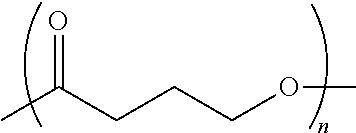Compositions and devices of poly-4-hydroxybutyrate
a technology of polyhydroxybutyrate and polymer, which is applied in the field of medical devices of poly4hydroxybutyrate, can solve the problems of inability to meet the requirements of the medical implant, etc., and achieves the effects of low cost, low cost and minimal loss of polymer molecular weigh
- Summary
- Abstract
- Description
- Claims
- Application Information
AI Technical Summary
Benefits of technology
Problems solved by technology
Method used
Image
Examples
example 1
Washing of P4HB Biomass with Ethanol
[0081]A biomass containing P4HB (Mw of 468 kDa, by Gel Permeation Chromatography (GPC) relative to standards of polystyrene), prepared according to Example 1 of WO 99 / 32536 to Martin, was suspended in ethanol at room temperature. After one hour, the P4HB biomass was removed by filtration, and the ethanol wash concentrated to yield a black tar. Analysis of the tar by 1H-NMR demonstrated that the ethanol extract of the P4HB biomass was composed almost entirely of saturated and unsaturated lipids. The nitrogen content of the tar was also determined to be 0.65 wt %.
example 2
Purification of Ethanol Washed P4HB Biomass
[0082]The ethanol washed P4HB biomass derived from Example 1 was centrifuged in a basket centrifuge to remove the bulk of the ethanol washing solution. The P4HB polymer was extracted into an organic solvent, precipitated into aqueous ethanol (30%), and collected for analysis. The nitrogen content of the P4HB polymer extracted from the ethanol washed P4HB biomass was found to be 37 ppm as determined by the Kjeldahl method (Bradstreet, Anal. Chem., 26(1):185-187 (1954). The carbon and hydrogen mass fractions of the purified P4HB polymer were determined by elemental combustion analysis using a LECO CHN 2000 instrument (following the manufacturer's instructions), and were found to be 55.89% and 7.05%, respectively. These values are close to the theoretical values for poly-4-hydroxybutyrate: carbon 55.81%, and hydrogen 7.02%. No significant loss of molecular weight of the P4HB polymer was observed. The weight average molecular weight of the puri...
example 3
Analysis of P4HB Purity by GC
[0083]The purity of a P4HB polymer in an unknown sample may be measured by gas chromatography after derivatization of the polymer using a butanolysis reaction to form volatile esters. The butanolysis reaction is an acid-catalyzed transesterification reaction with 1-butanol that converts the P4HB polymer into two major derivatives, butyl-4-hydroxybutyrate and butyl-4-chlorobutyrate. The latter yields a sharp peak in the GC chromatograph that can easily be integrated, and its peak is proportional to the amount of P4HB in the sample.
[0084]The reagent for the butanolysis reaction is prepared by mixing equal parts (v / v) of 1-butanol and 4M hydrochloric acid (HCl) in 1,4-dioxanone to yield a solution of 2M HCl in butanol / dioxane. An internal standard, such as diphenylmethane, may be added to the solution at a concentration of 2.0 mg / ml to normalize injection volumes.
[0085]The butanolysis reaction is performed by adding 3 mL of the butanolysis reagent (prepared...
PUM
| Property | Measurement | Unit |
|---|---|---|
| tensile strength | aaaaa | aaaaa |
| melt temperatures | aaaaa | aaaaa |
| weight average molecular weight | aaaaa | aaaaa |
Abstract
Description
Claims
Application Information
 Login to View More
Login to View More - R&D
- Intellectual Property
- Life Sciences
- Materials
- Tech Scout
- Unparalleled Data Quality
- Higher Quality Content
- 60% Fewer Hallucinations
Browse by: Latest US Patents, China's latest patents, Technical Efficacy Thesaurus, Application Domain, Technology Topic, Popular Technical Reports.
© 2025 PatSnap. All rights reserved.Legal|Privacy policy|Modern Slavery Act Transparency Statement|Sitemap|About US| Contact US: help@patsnap.com


